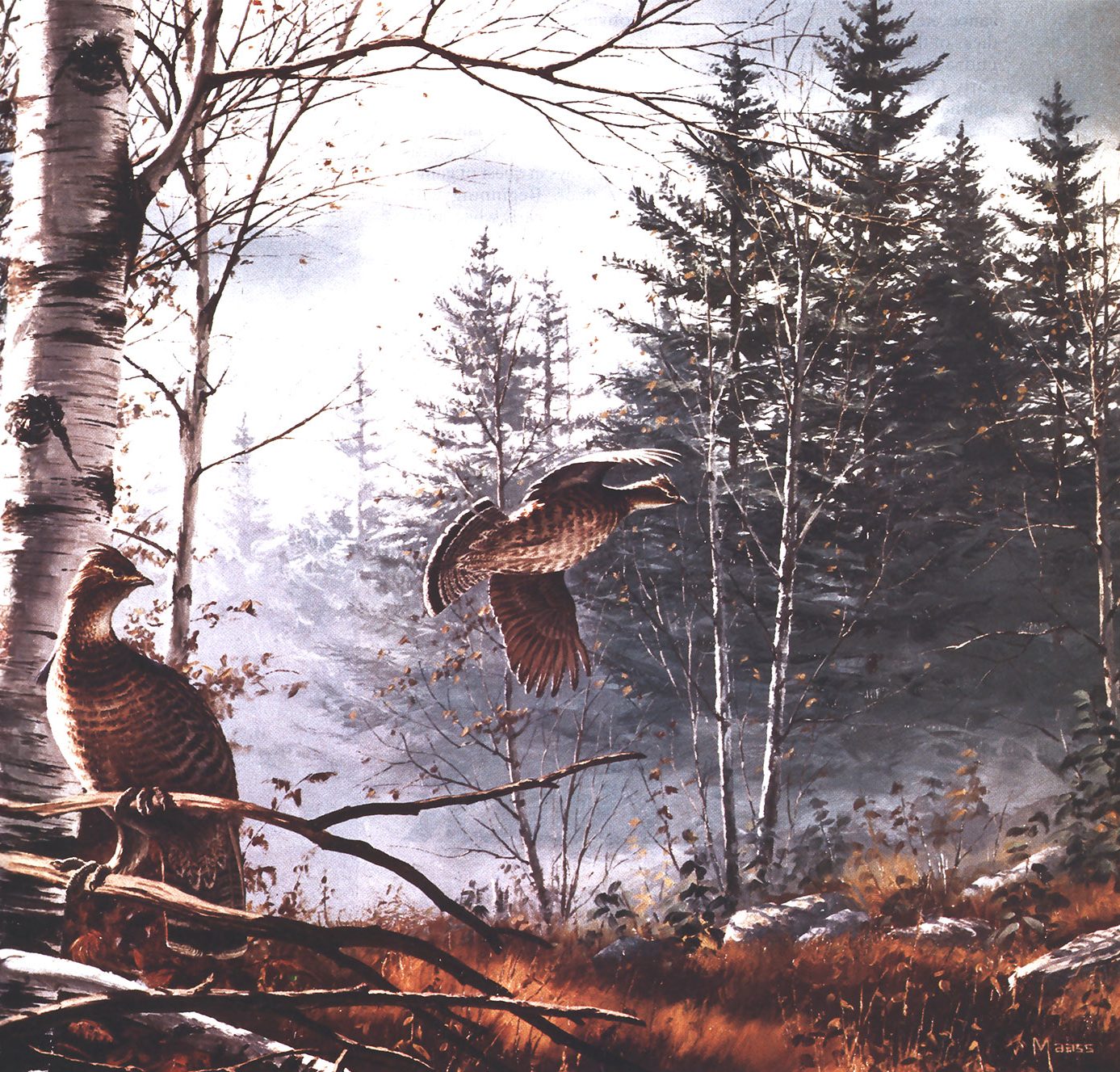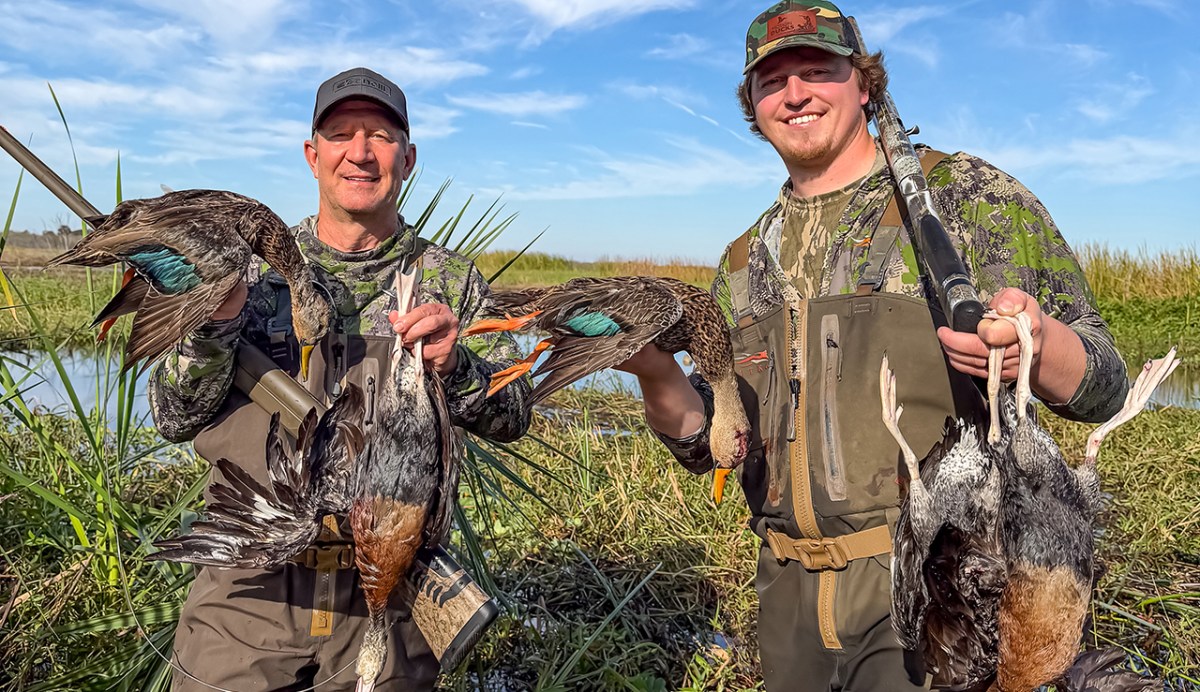The Best Grouse Hunting in America Isn’t Where You Think

This story, “Best Grouse Hunting in America,” appeared in the Sept. 1985 issue of Outdoor Life.
Bob Barbo is known as a duck hunter. His family cars have never seen the inside of the garage. It is reserved for two duck boats and vast piles of decoys. His dog is a Chesapeake and he shoots a marsh-worn Browning auto five. But in spite of his preoccupation with waterfowl, I talked him into going ruffed grouse hunting. Even though he had lived most of his life in the center of some of the very best ruffed grouse country in North America, he told me that he had never given any thought to hunting the birds.
We drove through La Grande, Oregon, and into the Wallowa Mountains on the Oregon/Idaho border. I kept up a steady ruffed grouse praise song. Bob seemed interested, but he was still somewhat guarded.
We planned to hunt a river bottom where I had followed an elk herd a few years before. I didn’t get an elk, but I was amazed at the number of grouse that I jumped. The whole week followed the same pattern. I never saw a bull but could hardly step over a log without a grouse roaring up in my face. Just about all the birds flew — and strongly. That did interest Bob. He had seen ruffed grouse in Oregon, and remarked: “They sure can be tame.”
We drove down a logging road and reached the river at lunchtime. We stopped to water Bob’s dog and let our boys throw a few rocks to shake out the kinks. There was a camp nearby and Bob guessed that its occupants were trout fishermen. I walked down to find out. Their station wagon had Virginia plates, and then I saw a big pile of grouse feathers.
“How’s the hunting?” I asked one fellow who came out of the tent as I walked up.
“Couldn’t ask for better,” he said with a Southern drawl. “We all got our limits early this morning.”
“Your limits?” I asked with some amazement as I did a head count of the three other hunters sitting in the tent.
“Yes, 12 birds between us. This river bottom is full of birds,” he replied.
All four were from Virginia, and they had come to Oregon to hunt ruffed grouse. They had fished the blue-ribbon trout waters of Montana and Wyoming and were rounding out their trip with Oregon grouse. One fellow had been making much the same trip for five years.
After he disappeared into the brush, we heard two series of shots about five minutes apart.
“Some years we hunt grouse over in Idaho; last year we decided to try Oregon,” he told me. “Both states have a lot of birds.”
I was less than casual when I rejoined Bob and the boys. We ate our own quick lunch and moved upriver a mile. I stayed with the boys, who were both too young to hunt, while Bob took the dog across the river into some good-looking cover. A very brief time after he disappeared into the brush, we heard two series of shots about five minutes apart. Then he waded back. He was no longer neutral; he was excited.
“We jumped two bunches,” he told me. “I shot my limit before I walked a quarter of a mile. It was pure luck or there are a lot of birds in this bottom!”
The latter proved correct. In three days, we flew 54 ruffed grouse and limited out each day. The rest of the time, we fished the river for trout.
When I got back to Salem, I called Ken Durbin, the managing editor of the Oregon Department of Fish and Wildlife’s magazine, Oregon Wildlife. Ken is among the most avid ruffed grouse hunters in the state. He listened to me ramble on about the total number of birds that we had flushed; then he told me that he had hunted nearby with four other people and that they had jumped more than 70 ruffed grouse during the first two days.
In fairness, I must say that the year all this happened was 1979, a year bird hunters in the West won’t soon forget. Many upland birds — quail, chukar, Huns, pheasants, grouse — were at staggering population peaks. Oregon’s ruffed grouse were especially abundant. Another 1979 may not come around again for years but, even with out the dramatic population boom, ruffed grouse hunting over a wide area in Oregon, Idaho, and Washington is often as good as anyone could desire.
In the Northwest, there are two very different ruffed grouse populations. The first tends to be somewhat localized in the mountain ranges of eastern Oregon, Washing ton, and western Idaho. The other is much larger and exists on the western slopes of the mountain ranges bordering the Pacific from Alaska southward to Northern California. In the two regions, there are also several races of ruffed grouse. Most important are the Columbian ruffed grouse and the Pacific ruffed grouse. There is little difference between the two, except in the plumage. The Columbian is a gray phase bird found in the eastern regions; the Pacific is a red-phase bird found on the western slopes.
Dr. John A. Crawford of the Department of Fisheries and Wildlife at Oregon State University is a leading researcher on Western upland birds. He is also a keen grouse hunter, an importer of British shotguns, and co-author of the book, The History of W.&C. Scott, Gunmakers.
In answer to a question that I asked him regarding Eastern ruffed grouse hunting versus Western, he told me: “I have never hunted ruffed grouse in the East, but it would be very difficult for me to imagine better grouse hunting there than we have in the Northwest. Several of my friends from the East come out to hunt with me.
“In 1983, a friend from North Carolina a ruffed grouse man to the core — came here to hunt. I was able to put him into some fine shooting. We started in northeastern Oregon and bagged limits on both days. I came up with a field estimate of about 30 grouse per mile of river bottom.”
He went on to explain why there are large numbers of ruffed grouse in the mountain regions of eastern Washington and Oregon, and in adjacent Idaho.
“The key is the riparian zone. This zone is characterized by deciduous trees such as dogwood, alder, and aspen surrounded by conifer forest. The riparian zone is almost entirely confined to creek or river bottoms. In general terms, this zone is rather limited and doesn’t extend far up the slopes. It’s fine habitat for ruffed grouse.”
“If my sons and I didn’t bag between 60 and 100 ruffed grouse in those 30 days, we considered it a poor season.”
For the Eastern grouse hunter, the large numbers of ruffs in these limited areas of the Northwest may be overwhelming, and there are very few ruffed grouse hunters. Rocky Beach of the Washington Depart ment of Game told me: “We don’t have any grouse hunters to speak of. The bird is the most underharvested upland species in the state. We wish that we could get more hunters into grouse hunting. The birds are certainly there. We did some flush counts out of Spokane a few years ago and came up with 200 flushes per day per man. This type of flush count, of course, includes birds flushed more than once, but that’s still a lot of birds.”
Marty Morache of the Idaho Fish and Game Department told me that Idaho has good ruffed grouse populations over much of the state. He especially noted the riparian zones in the northwestern region, the Panhandle of Idaho.
He went on to say: “Most of the ruffed grouse harvest is bagged by hunters who are going after other species, mainly deer and elk. There is a small contingent of ruffed grouse hunters in the state, but more people go after blue grouse on the mountain slopes than ruffed grouse in the thick bottoms.”
Much of the lack of interest in the ruffed grouse in the West is due to history. The Northwest didn’t have any real population influx until the 1880s. Even then, there was still a lot of elbowroom. Ringneck pheasants were established 20 years later, and most of the new settlers became pheasant hunters rather than grouse hunters. Over the entire Northwest, the only real exception was on Vancouver Island in British Columbia where a solid “Eastern style” ruffed grouse fraternity developed. Ducan Marshall and Skate Hames, both of Campbell River, British Columbia, told me about their many good days in the field with the times a season, season after season, the grouse became very wary.
Yet it is still difficult for many experienced Northwestern hunters to accept this. They have encountered too many tree-limb gawkers. Dr. Crawford said that about 60 percent of the birds that he encountered last year in eastern-Oregon river bottoms were strong flyers, and that there were some “real smokers” among them. He also offered that, in the riparian zones, one often finds so many grouse that little thought is given to those that don’t fly. He pointed out that he was hunting very early in the season over young birds. Later, birds going into their first winter are much smarter. Last December, in western Oregon northwest of Portland, Crawford and two friends jumped 19 grouse in a day-and all of them flew. Especially in Oregon, grouse seasons were formerly unnecessarily short. At that time, both eastern and western Oregon had a 30-day season in September. Eastern Oregon still has this season because of the concentration of grouse in the limited riparian zones.
Ralph Denney, staff upland bird biologist for the state, explained: “Few hunters take advantage of the ruffed grouse hunting in eastern Oregon but, because of the large number of birds that concentrate in river bottoms, overshooting could be a problem. Thirty days is, therefore, ample time. When I was a biologist in the field. I hunted ruffed grouse for 25 years. If my sons and I didn’t bag between 60 and 100 ruffed grouse in those 30 days, we considered it a poor season.”
But western Oregon is now open all of September, all of October. part of November, part of December, and the first two weeks of January. Due to the fact that it is nearly impossible to hunt grouse in western Oregon in September because of the leaves on the trees, most hunters who did go out for grouse in the past encountered them alongside logging roads. Such grouse have never been noted for being especially wild. But, with the new seasons, hunters are able to get into the woods for grouse after the leaves fall. They will hunt birds that differ markedly from the ones that gawked at them from the roadside.
Last November, Lonnie Waln together with my wife, Marge, and I, drove to a good grouse cover in the Coast Range west of Salem. Almost all the leaves were down. In three hours, we flew 14 grouse, and the birds thundered out of the brush in classic escape flight. Marge sometimes missed with both barrels, and Lonnie thinned a small tree that a grouse put between them.
Much of the lack of interest in the ruffed grouse in the West is due to history. The Northwest didn’t have any real population influx until the 1880s.
While the riparian zones are all important in the eastern portions, a single tree species appears to be the key on the western slope. Ruffed grouse are attracted by the fruit of a small, gnarled growth called the Oregon crab apple.
“As far as ruffed grouse on the west slope are concerned, that crap apple tree is pure magic,” Ken Durbin told me. “It is remark able how the birds seek it out.”
The tree has a wide range from British Columbia southward to California. I have found this tree more often in the Coast Range than in the Cascade Range. It usually grows near creeks and on the hillsides bordering them. More important, it often grows in groves over several acres.
Ten years ago, when I first decided to hunt ruffed grouse on a serious basis, I began in a crab apple grove in the Coast Range near Fall City. At that time, I was limited to the old west-slope September only season, but I had a few good days. When the season was lengthened to include October and November, the hunting improved dramatically. During the 1979 boom year, after the eastern side closed, I hunted almost entirely in that grove. During October, I had two limit days in the same week and killed a bird or two every time out. On the last day of the season, Ken Durbin and I flew eight grouse from a single crab apple tree. At the flush, a big flock of rob ins and cedar waxwings also flew from that tree. There were birds all over the place.
Even with an attraction like the crab apple tree, west-slope grouse hunting is not like hunting the bottoms on the eastern side. Even with the leaves off the trees, it is brushy, wet, and thick. Very often, you only hear the grouse leave.
John Crawford told me: “Western Washington or Oregon grouse hunting is not like hunting in New England. There arc few, if any, clearings, old apple trees, and old stone walls. You hunt in the Pacific rain forest, and you and the dog just have to go into thick cover and work the birds out.”
Shooting in thick cover requires quick reflexes, a light gun, No. 7½ or No. 8 loads, and an open choke. I use a 16-gauge Parker built on an “O” frame. It’s a shooter, not a collector’s item. Somewhere along the line, the barrels were cut from 28 to 26 inches, and that took out almost all the choke. A short distance away from the barrel, each pellet in the pattern shuns close contact with the others. It would be a great gun for exterminating a ground-feeding flock of English sparrows at 1O feet.
In three hours, we flew 14 grouse, and the birds thundered out of the brush in classic escape flight.
I don’t own a pointing dog, but I hope to hunt Western grouse over one someday. To date, the best dogs that I have hunted with were black Labs. One in particular was slow working, keen nosed, and close ranging.
I hunted in Oregon for almost 20 years before I tried for ruffed grouse. Now I can only wish that I hadn’t been so slow to try this fine sport. Now I’m secretive about the location of large crab apple groves and other productive cover. As yet, I don’t drive off in the wrong direction and then circle back to good cover, as some New Englanders are said to do in order to keep their favorite covers secret.
Three years ago, I was thunderstuck when I entered a special crab apple grove and ran into another hunter. I had never encountered another grouse hunter in the brush of western Oregon. I could only hope that he was hunting bandtail pigeons, but he had a Brittany and two fine grouse in his bag.
Read Next: I Shot the Third Biggest Elk of All Time
We fell into some guarded shop talk on crab apples and ruffed grouse. It wasn’t as though we had found each other’s safe deposit keys, but that particular grove isn’t large and is good for only five or six grouse a season, so we didn’t shake hands when we parted. I laugh about it now because there’s really more than enough good cover for everybody.
Read the full article here









